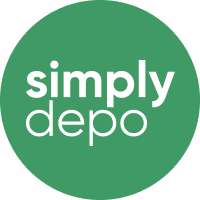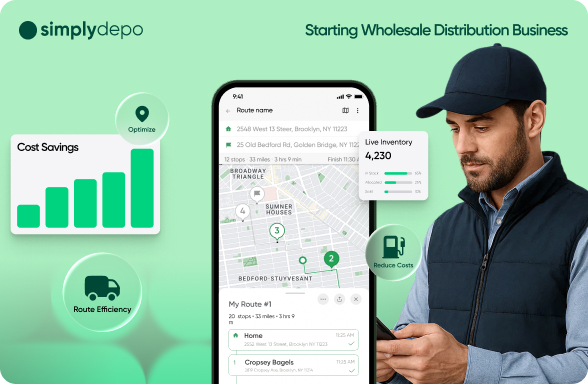Becoming a distributor used to be a straight shot: connect the maker with the store, win the shelf, keep product moving. In 2025, it’s a different game.
Costs are tighter, buyers are tougher, and shoppers expect zero stockouts. Retailers want OTIF delivery, clean planograms, and proof you did the work—or the chargebacks hit. The playbook has gone digital: paper routes and Excel counts won’t cut it. You need EDI, mobile route accounting, real-time inventory, GPS-stamped visits, photo compliance, and instant e-invoices with order confirmations and POD. That’s the bar now.
According to Deloitte’s Future of Sales Study companies that deploy mobile-first distribution tools see 18–25% higher rep productivity and shorten sales cycles by nearly 20%. Similarly McKinsey found that distributors who digitize workflows reduce lost sales by 30% and improve margins by 3–5%.
So if you’re asking how to become a distributor the answer goes beyond setting up an LLC and getting suppliers. To succeed you’ll need a distribution management system that integrates order management, inventory control and retail execution into one digital platform.
What Is a Distribution Business?
In short: a distributor buys from makers or wholesalers and resells to stores, service businesses, or even straight to customers—and unlike a wholesaler, they add the extras: logistics, warehousing, merchandising, and compliance reporting.
A distributor is the link between makers and retailers, sometimes direct to shoppers. You buy in bulk, hold stock, then resell to stores, other wholesalers, or consumers when it fits. You add value by:
- Storing and moving product: warehousing, pick and pack, routing, on-time delivery
- Managing relationships: orders, service levels, fill rates
- Field sales and merchandising: reps take orders, set displays, check pricing and promos
- Offering working capital: credit terms, invoicing, collections
- Data and compliance: photo proof, planogram checks, EDI, scorecard reporting
💡 Pro Tip
Tech-enabled distributors using B2B Order Management System see fewer manual errors and better buyer retention, unlocking long-term margin growth without increasing prices.
Challenges and Opportunities of the Distribution Landscape
The global distribution industry has entered what McKinsey calls the “next normal,” a period defined by volatility, technology adoption, and rapidly shifting consumer demand.
Challenges Facing Distributors
- Margin Pressure: Inflation and supply chain disruptions squeeze profit margins. Distributors need efficiency to survive.
- Retail Compliance: Retailers now expect proof of execution—planogram adherence, promo activation, and pricing compliance.
- Data Demands: Brands want real-time sales, shelf, and inventory data, not weekly spreadsheets.
- Workforce Productivity: Field reps often juggle multiple apps, manual reporting and unclear routes leading to inefficiency.
Opportunities Emerging in 2025
- Niche Specialization: Small distributors are thriving in plant-based foods, wellness products, and ethnic specialties.
- Regional Strength: Local distributors can respond faster to stockouts than global suppliers.
- Digital Transformation: Adoption of mobile retail execution solutions creates competitive advantages.
- Value-Added Services: Offering insights and execution reporting makes a distributor more valuable to brands.
Distribution Business Models
The traditional “buy low, sell high” wholesale strategy has evolved.
Direct Distribution
Manufacturers sell directly to retailers, often using in-house reps. Effective but costly for small brands. Indirect Distribution Brands partner with third-party distributors who manage relationships, logistics and execution. Most common in CPG.
Hybrid Models
Many brands now use a hybrid approach—self-distribution in core markets and outsourced distributors in expansion regions.
Distribution vs Wholesale
- Wholesale: Focuses on bulk transactions with minimal added services.
- Distribution: Provides execution, marketing, logistics and compliance.
The best distribution business model is hybrid + digital-first—offering flexible coverage while maintaining efficiency through technology. Distributors make money primarily through margin between supplier cost and retailer price.
Average Profit Margins by Industry
| Sector | Margin | Notes |
| Food and Beverage | 10–15% | Volume-driven |
| Specialty Foods | 20–25% | Premium pricing |
| Beauty and Personal Care | 25–35% | Brand-driven |
| Electronics Accessories | 15–20% | Logistics intensive |
“By digitizing with SimplyDepo, we reduced mistakes, improved supplier trust, and ultimately made more money without raising prices.” — Tenace Incubation
Harvard Business Review confirms that efficiency improvements often have a greater impact on profit than top-line growth.
Requirements for Distributorship
- Startup capital (inventory, vehicles, logistics)
- Legal entity registration + state licenses (SBA Guide)
- Supplier agreements (with clear terms)
- Insurance (liability, product, transport)
- Technology setup (CRM for Distributors, ERP, SimplyDepo)
- Sales & operations team
How to Start a Distribution Business: Step by Step
- Market Research → Analyze demand, competition, suppliers using reports from Harvard Business Review and SBA.
- Business Plan → Draft a full distribution business plan (financials, operations, sales).
- Legal Setup → Register your entity, secure licenses.
- Supplier Contracts → Negotiate exclusivity and favorable terms.
- Logistics Setup → Choose between 3PL or owned warehouse.
- Sales Strategy → Build field sales team, online ordering, and B2B relationships.
- Technology Deployment → Use SimplyDepo for orders, catalog, invoices, CRM.
- KPI Monitoring → Track margin, retention, order accuracy.
Why Distributor Management Systems Are Needed
The days of managing orders through phone calls and Excel are over. Modern distributors use distributor management software to streamline operations.
Core Features of a Distribution Management System
- Order capture – mobile, offline-capable with product catalogs.
- Inventory management – barcode scanning and stock visibility.
- Retail execution audits – photo proof, checklists and GPS-verified visits.
- Analytics dashboards – real-time insights for reps, managers and HQ.
McKinsey Insight: SMB distributors using mobile-first distribution management tools cut operational costs by 15% and reduce order-to-cash cycles by weeks.
Here are some of the features and criteria that distinguish these tools — and that you should weigh when comparing distribution management software. These also help show where SimplyDepo pulls ahead or might need trade-offs.
| Feature | Why It Matters | Tools Comparison |
| Mobile Order & Visit Capture | Field reps need to enter orders on the go, conduct audits, planogram checks, capture photos, etc. | NetSuite, Acumatica, SYSPRO offer mobile access. ERPNext & Odoo can be extended. SimplyDepo was built mobile-first, so minimal friction here. |
| Real-Time Inventory & Barcode | Critical to avoid stockouts, overselling, lost sales. Improves fill rate & margins | Advanced in NetSuite & SYSPRO. Odoo & ERPNext decent. SimplyDepo also supports barcode scanning & inventory visibility. |
| Retail Execution. Compliance Audits | Brands & retailers demand proof photos, checklists, GPS, non-compliance can result in chargebacks | Less mature in ERP products by default. Need extra modules. SimplyDepo has built-in audit execution tools. |
| Analytics & Dashboards | To know what’s working, what’s not. Batch vs route performance; margins, cost centers | Strong in NetSuite, Acumatica. open tools have flexibility. SimplyDepo has real-time dashboards tuned for distributor & brand use cases. |
| Integration & Extensibility | Need to connect to ecommerce, CRM, accounting, logistics, scale geographically or into new channels | Enterprise ERPs tend to offer many built-in integrations or API flexibility but with complexity. SimplyDepo offers seamless integrations and more lightweight onboarding. |
| Pricing & Time to Deploy | Lower risk & faster ROI matter especially for SMB, mid-market | ERP systems (NetSuite, SYSPRO) tend to have higher cost and longer deployment. Open source tools may have lower licensing cost but higher setup cost. SimplyDepo aims for fast setup, lower cost of ownership. |
| Scalability | Ability to handle multiple warehouses, many users, international operations | Strong for NetSuite, Acumatica, SYSPRO, open source tools variable. SimplyDepo built to scale but with some upper limits in the most complex enterprise scenarios. |
Invest in Distribution System
Running a distribution business manually is nearly impossible at scale. Modern distributors rely on wholesale distribution software like SimplyDepo to:
- Automate order-taking (field sales app)
- Manage inventory in real-time
- Optimize delivery routes
- Provide digital catalogs for buyers
- Integrate with accounting tools
💡 Pro Tip
Many SMB distributors start lean by outsourcing logistics to 3PLs before scaling into owned warehouses.
SimplyDepo vs. Alternatives
| Feature | SimplyDepo | Pepperi | Repsly |
| Usability | Intuitive UI | Complex B2B eCommerce focus | Steep learning curve |
| Pricing | Transparent Core Plan | Premium pricing tiers | Hidden costs |
| Integrations | QuickBooks, Stripe, Zebra | ERP/CRM heavy | Limited |
| Setup | Fastest setup | Weeks | Weeks |
| Best For | SMB distributors & brands | Mid-to-large distributors | Enterprise/field teams |
⭐ SimplyDepo is rated 4.7 on G2, consistently praised for usability and fast setup.
⭐ Pepperi is rated 4.4 on G2, known for strong ERP integrations but higher complexity.
⭐ Repsly is rated 4.3 on G2, favored for field data collection but noted for a steeper learning curve.
💡Pro Tip
Consolidate workflows into fewer tools to avoid inefficiency. SimplyDepo provides an integrated suite for SMB distributors.
Case Studies: Distributors Succeeding with SimplyDepo
| Distributor | Challenge | Solution | Results |
| Tenace Incubation Case Study | Order errors | Mobile orders + invoicing | 70% fewer errors, 3× faster reps |
| 88 Acres Case Study | Spreadsheet orders | Field sales automation | +30% reorders, +15% new buyers |
| HC Foods Case Study | Retention issues | Buyer insights + CRM | +15% revenue, 40 hrs/week saved |
| Brickyard Brands Case Study | Poor margin tracking | Analytics + automation | 2× margin accuracy, +20% productivity |
Global Distributor Success Stories
- Sysco (USA): $75B+ giant scaling through acquisitions (Sysco Annual Report).
- Ingram Micro (Global): IT leader with global reach (Ingram Micro).
- D&H Distributing (USA): Focused on SMB resellers (D&H Distribution).
- Supreme Components (Asia): Electronics distributor scaling through global partnerships (SCI).
Distributor Best Practices
1. Go Mobile-First
Give every rep a mobile app to place orders, capture audits and submit reports.
2. Automate Reporting
Replace manual Excel sheets with real-time dashboards that update automatically.
3. Optimize Routes
Use route sales software to maximize rep productivity and reduce travel costs.
4. Enforce Retail Compliance
Track planogram adherence and promotions with photo evidence and checklists.
5. Standardize Workflows
Create templates for audits, pricing checks and order entry to ensure consistency
How to Value a Distribution Business
If you’re looking to invest in or sell a distributor business.
Methods of Valuation
- Revenue Multiples: Small distributors are valued at 0.5-1.5x annual revenue.
- EBITDA Multiples: 4–7x EBITDA depending on category.
- Asset-Based Valuation: Warehouses, vehicles and exclusive contracts add value.
Key Drivers of Value
- Strong supplier contracts.
- Technology adoption (distributors with a DMS get higher multiples).
- Diversified customer base.
- Operational efficiency.
Best Distribution Business Ideas
Fastest growing distribution business ideas this year:
- Functional beverages: health shots, kombucha, nootropic drinks.
- Plant-based foods: meat alternatives, dairy-free, vegan snacks.
- Wellness products: supplements, natural skincare, essential oils.
- Eco-friendly packaging: sustainable materials for F&B and retail.
Ethnic specialties: authentic regional food and beverage products.
Distribution Success
Being a distributor in 2025 is more than just moving boxes. It’s data-driven execution, mobile-first workflows and automation. Distributors who invest in distribution management software like SimplyDepo will win:
- 70% fewer order errors (Brickyard Brands).
- 3x faster reporting (HC Foods).
Best distribution business is the one powered by smart technology.
How to Become a Distributor FAQ
What is a distribution business, and how is it different from wholesale?
A distribution business purchases products from manufacturers and sells them to retailers or other businesses. Distributors often manage storage, logistics, and field sales. Wholesale businesses typically buy in bulk and resell but may not handle delivery or brand-specific territories. Think of distributors as logistics and relationship experts in the supply chain.
How much does it cost to start a distribution business?
Starting a distribution business typically requires between $10,000 and $100,000, depending on your industry, inventory size, warehouse needs, and staff. Small distribution business ideas like becoming a specialty product distributor or dropship distributor can start with less capital.
Can I become a distributor without a warehouse?
Yes. Many successful distribution businesses begin by using third-party logistics (3PL) providers or cross-docking models to cut warehousing costs. These flexible models are ideal if you’re learning how to start a distribution business on a budget.
What industries offer the best distribution opportunities?
Some of the most promising industries for new distributors include food and beverage, beauty and wellness, consumer electronics, and eco-friendly products. These categories tend to offer healthy margins, consistent demand, and growing B2B interest. When deciding how to start a distribution business, it’s important to align your niche with both your interests and market demand.
How do distributors make money?
Distributors earn revenue from the profit margin between the cost of goods from the manufacturer and the resale price to retailers. Efficient inventory management, good supplier deals, and tools like SimplyDepo increase margins without raising prices.
What are the most scalable distribution business models?
The right distribution business model depends on your capital, goals, and industry. Exclusive distributors work under contracts with a specific brand in a defined territory, while wholesale distributors sell in bulk to retailers without exclusive agreements. Some entrepreneurs choose a broker model, facilitating deals without managing inventory at all. If you’re just learning how to start a distribution company, begin with the model that aligns with your network and financial comfort.
What’s the difference between becoming a wholesale distributor and a traditional distributor?
A wholesale distributor typically buys in bulk and resells to other businesses, focusing on volume. A traditional distributor may offer more services, including marketing support, field reps, and exclusive territory management.
Do I need distribution software to get started?
While not strictly required in the beginning, modern distribution businesses rely heavily on software to manage sales, orders, inventory, invoicing, and analytics. SimplyDepo is one example of a platform that helps new distributors streamline field operations, manage reps, and offer digital catalogs to retailers. Starting without tech might be possible, but scaling without it is almost impossible.
Boost Sales.
Cut Manual Work.
Streamline ordering, routing, and retail execution — while giving every rep the tools to grow accounts faster.
-
+15h
Save weekly
per rep -
93%
Increase
buyer retention -
24%
Increase
in retail sales

Error: Contact form not found.











